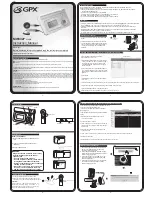
S E T U P M E N U O P T I O N S
28
Remember that excessive noise reduction may cause a loss of detail. We recommend using the noise
reduction function only when you encounter poorly encoded or compressed video that has apparent
noise artifacts.
9.
HDR-SDR Adj
. : Allows you to adjust the target luminance for better HDR to SDR conversion. The
luminance content higher than the target luminance will be maped into the luminance range lower than
the target luminance.
Select the Best Output Resolution
One of the major advantages of the UBR-X100 / X110 / X200 players is their ability to play Ultra High-Definition Blu-
ray video (UHD) and also up-convert high-definition video (HD) and standard definition video (SD) to Ultra High-
Definition. The players offer several standard, HD and UHD video output resolutions. For best results, it is important
to select an output resolution that best matches your TV or display.
The goal is to select the native resolution of your TV or to get as close to it as possible. Native resolution is the
number of pixels (dots) that the diffuser matrix can actually display, whether it is a plasma or OLED panel, an LCD or
DLP ™ matrix, or any other display technology. TVs generally accept signals at both higher and lower resolution than
their native resolution. In this case, the electronics of the TV convert the input signal to match the native resolution.
Unfortunately, in most cases this process results in very poor image quality. So if you set the output resolution of the
UBR-X100 / X110 / X200 closer to your TV's native resolution, you will be able to get an exceptional picture. Most
TVs and projectors can communicate their native resolutions to the player via HDMI. Setting the
Resolution
to
Auto
is generally the best choice for users. However, in some cases, TVs or projectors may not present their native
resolutions correctly, or decide that a certain resolution is more appropriate.
For most new displays on the market, the best output resolution will be either UHD or 1080p. A few early model
“1080p” displays did not accept a 1080p signal. For these displays, the best output resolution is 1080i. For small
screen digital TVs this will likely be 720p. For even earlier CRT tube or rear projection TVs this will likely be 1080i. For
EDTV displays (very rare if they have HDMI or DVI) this will be 480p (NTSC) or 576p (PAL). These are general
recommendations that work for most users, but there can be exceptions. Advanced users may want to try all
supported resolutions and choose the one that provides the best result visually.
UBR-X100 / X200 players support a special
Source Direct
mode through their HDMI outputs. This resolution is
recommended for use with external video processors or high-end TVs. In
Source Direct
mode, the players work as a
“transport”. They decode video from the discs and then send the raw video signal in its native resolution and format,
without extra processing, to the external video processor or TV. The actual output resolution varies by content :
Content
Source Direct Output Resolution
NTSC DVD
480i
PAL DVD
576i
Most Blu-ray Movies (film-source)
Ultra HD (4K) 23.976Hz or Ultra HD (4K) 24Hz
1080p 23.976Hz or 1080p 24Hz
Most Blu-ray TV shows or Concerts
(video-source)
1080i
SACD (UBR-X110 / UBR-X200) and
DVD-Audio
1080p
You can switch between Auto mode and one of the preset resolutions by pressing the
RESOLUTION
button on the
remote control.
















































